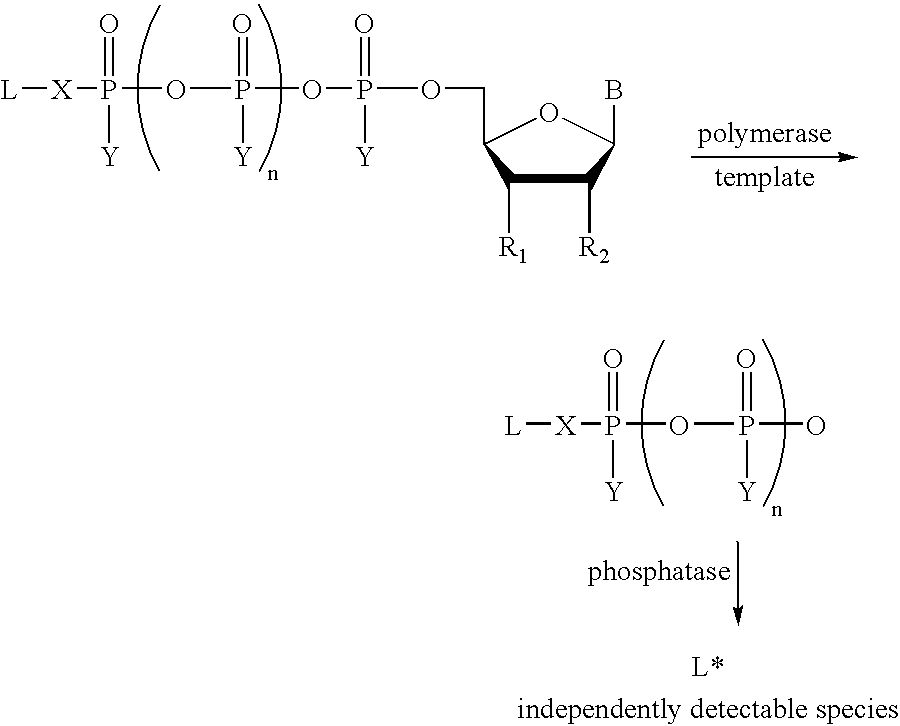Allele specific primer extension
a primer and allele technology, applied in the field of allele specific primer extension, can solve the problems of difficult detection and characterization of trace amounts of target nucleotides in samples, requirement for strict temperature control, and insufficient quantification due to logarithmic amplification
- Summary
- Abstract
- Description
- Claims
- Application Information
AI Technical Summary
Benefits of technology
Problems solved by technology
Method used
Image
Examples
example 1
[0089] Preparation of 6-9H(1,3-dichloro-9,9-dimethylacridin-2-one-7-yl)-th-ymidine-5'-tetraphosphate (dT4P-DDAO) and other dye-linked tetraphosphates
[0090] 10 .mu.moles TTP TEA salt was evaporated to dryness. To the residue was added 40 .mu.moles tributylamine and 5 ml dry pyridine. The solution was re-evaporated to dryness. After 2 coevaporations with 3 ml dry dimethylformamide (DMF), residue was re-dissolved in 200 .mu.l dry DMF, flushed with argon and stoppered. Using a syringe, 50 .mu.moles (8 mg) carbonyldiimidazole (CDI) dissolved in 100 .mu.l dry DMF was added. The flask was stirred for 4 hr at ambient temperature.
[0091] While the above reaction was progressing, 35 mg (83 .mu.moles) DDAO phosphate and 166 .mu.moles tributylarnine were dissolved in dry DMF. The DDAO phosphate was evaporated to dryness followed by 3 coevaporations with dry DMF. Residue was dissolved in 300 .mu.l dry DMF.
[0092] After the 4 hr reaction time, 3.2 .mu.l anhydrous methanol was added to the TTP-CDI r...
example 2
[0099] Discrimination of alleles using an allele specific primer and terminal phosphate labeled nucleoside polyphosphates
[0100] The following primers and templates were used in Examples 2, 3 and 4.
5 Primers: 5'-GTT CTC GGC ATC ACC ATC CG(s)T-3' (SEQ ID NO: 9) 5'-GTT CTC GGC ATC ACC ATG CG(s)T-3' (SEQ ID NO: 10) 5'-GTT CTC GGC ATC ACC ATC GG(s)T-3' (SEQ ID NO: 11) Templates: 5'-CAC CCT TAT CTG GTT GTC GAC GGA TGG TGA TGC CGA GAA C-3' (#1, SEQ ID NO: 12) 5'-CAC CCT TAT CTG GTT GTC GGC GGA TGG TGA TGC CGA GAA C-3' (#2, SEQ ID NO: 13) 5'-CAC CCT TAT CTG GTT GTC GCC GGA TGG TGA TGC CGA GAA C-3' (#3, SEQ ID NO: 14) 5'-CAC CCT TAT CTG GTE GTC GTC GGA TGG TGA TGC CGA GAA C-3' (#4, SEQ ID NO: 15)
[0101] Reactions were assembled at room temperature (23.degree. C.) using the deoxynucleotides of Example (1). Reactions contained primer template combinations having a single oligonucleotide primer (represented by SEQ ID NO: 9) annealed to one of two different oligonucleotide templates with either a...
example 3
Discrimination of Alleles Using an Allele Specific Primer and Terminal Phosphate Labeled Nucleoside Polyphosphates: Effect of Internal Mismatches
[0105] For FIG. 4a, primer with a sequence of SEQ ID NO: 9 and template #1 or template #2 with correct or incorrect base at 3'-end was used. For FIG. 4b, primer with a sequence of SEQ ID NO: 10 with internal mismatch three bases away from the 3'-end and template #1 or template #2 with correct or incorrect base at 3'-end was used. FIG. 7 is a schematic drawing showing the annealed primer / template pairs as used in Example 3 of the current invention.
[0106] The experiment was carried out essentially in the same manner as reported above in example 2. The results are shown in FIG. 4. It is clear that the internal mismatch enhance the signal to background ratio by approximately ten folds.
PUM
| Property | Measurement | Unit |
|---|---|---|
| Electrical resistance | aaaaa | aaaaa |
| Fluorescence | aaaaa | aaaaa |
| Chemiluminescence | aaaaa | aaaaa |
Abstract
Description
Claims
Application Information
 Login to View More
Login to View More - R&D
- Intellectual Property
- Life Sciences
- Materials
- Tech Scout
- Unparalleled Data Quality
- Higher Quality Content
- 60% Fewer Hallucinations
Browse by: Latest US Patents, China's latest patents, Technical Efficacy Thesaurus, Application Domain, Technology Topic, Popular Technical Reports.
© 2025 PatSnap. All rights reserved.Legal|Privacy policy|Modern Slavery Act Transparency Statement|Sitemap|About US| Contact US: help@patsnap.com



